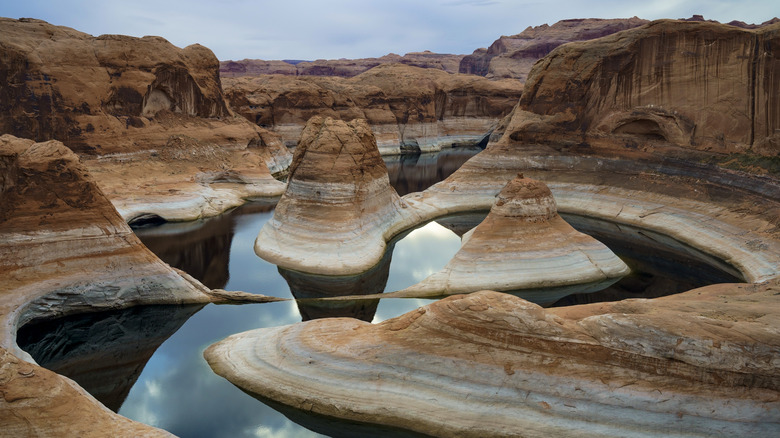The Sad Reason Why A Lake Known As The 'Jewel Of The Colorado' Is Also Called 'America's Lost National Park'
Lake Powell is a striking body of water surrounded by cliffs and structures of rusty, layered, Jurassic-age Navajo Sandstone, studded with minuscule quartz crystals that glimmer when the desert sun hits. Situated between Red Rock Canyon, which straddles Utah and Arizona, Lake Powell, one of the prettiest and most unique lakes in America, is rightfully nicknamed the Jewel of the Colorado. The brilliantly blue lake — the second-largest artificial reservoir in the U.S. after the neighboring Lake Mead — has long been a popular destination for outdoor adventures and breathtaking vistas.
In the past two decades, however, the water levels in Lake Powell have been slowly but noticeably decreasing each year. In 2022, a "megadrought" caused an alarming amount of water loss, dropping the lake to a record-low 26% capacity. Runoff from precipitation on the Colorado River – which flows into Lake Powell — was also at record lows. Experts attribute this to carbon emissions-caused climate change as well as long-term aridification that affects ecosystems and changes weather patterns. Paired with increasing demand on the water system, the water supply plummeted at Lake Powell. Boat ramps closed, rocks from the bottom of the lake that had once fully been covered by water emerged, and hydropower faltered. A water shortage was declared all along the Colorado River, affecting 40 million users.
By mid-2023, water levels started to slowly increase. By 2025, while still relatively low, they were expected to "remain steady," per a compilation of National Parks Briefs by the National Parks Traveler. Eric Balken, executive director of Glen Canyon Institute, summarized it this way: "All of the best data that we have suggests it's going to be mostly empty for now on, so I think it's really important for policymakers to consider what phasing out this reservoir looks like."
The Jewel of the Colorado came with a conflicting cost
Here's the twist: The Jewel of the Colorado is also known as "America's Lost National Park" because the creation of Lake Powell buried a canyon, changed the natural landscape, and infuriated conservationists with its egregious land repurposing. In 1956, construction began in Glen Canyon on a Colorado River dam, aiming to create a fresh water supply for the area. President Eisenhower detonated the first dynamite blast that carved into the canyons what would soon be the depths of Lake Powell, but it was 10 years before hydropower started working. Glen Canyon National Recreation Area was established in 1972, and in 1980, the lake finally reached capacity, about 8.8 trillion gallons, or "enough water to flood the entire state of Kentucky a foot deep," as NPR noted.
The dam provided beneficial water supply, irrigation systems, hydroelectric power, and funding for environmental programs, and the lake became a destination for boaters and houseboaters, logging millions of visitors annually. Camping, hiking, and horseback riding abound, and Lake Powell's 1,960 miles of shoreline are pockmarked by nearly 100 breathtaking canyons, including Antelope Canyon and less-crowded alternatives like the hidden gem Cardiac Canyon.
Yet the engineering glory and outdoors enthusiasm cost the area its natural geology, drowning a canyon filled with sandstone arches, rock pillars, and even Indigenous rock paintings; endangering flora and fauna; hosting radium-tainted silt and toxic algae blooms; and ignoring Indigenous tribes' interests. It's been referred to as "an environmental Pearl Harbor" by some and was lambasted by writer Edward Abbey, who wrote an entire novel based on his anger toward the dam project. Changing water levels and erosion even caused the collapse of the famous "Toilet Bowl" arch in 2024.
Lake Powell's water decline could have a silver lining, but it may be too little, too late
Even though mountain snowmelt helped replenish some of the depletion in 2023 and 2024, long-term drought remains, and Lake Powell's water levels are trending downward, and experts say it's critical to start making changes. Meanwhile, Lake Mead is facing similar difficulties. The largest artificial reservoir in the U.S. was created downriver from Lake Powell in 1935 with the Hoover Dam and, similar to its sister Lake Powell, attracts millions of visitors annually and supplies a great amount of water to the surrounding region. Despite its popularity, Lake Mead is considered the most dangerous national recreation area in America, and the conditions there are worsened by climate change and water depletion.
The entire western United States is at risk, including California, a thriving agricultural hub and the citrus capital of the world, which maintains groves of fruit trees and fields of everything from tomatoes to almonds to dairy, all of which require tons of water. Along with Utah and Arizona, the conversation continues as to how to prioritize water conservation while best managing the land. As Felicia Marcus, former chair of the California State Water Resources Control Board, said, "We all need to become far more water literate because there are some hard choices ahead."
As water slips further below its "full pool" point, the "lost national park" could be creeping back into existence. As water levels decrease, more from the depths of Lake Powell is revealed. "Nature is healing," some might say, a little ironically. Glen Canyon, a.k.a. Lake Powell has sustained damaging water erosion, the ever-increasing impact of climate change, and a significant loss of water supply to the region's inhabitants and agriculture industries. The price of rediscovering America's Lost National Park might, sadly, be too high.


